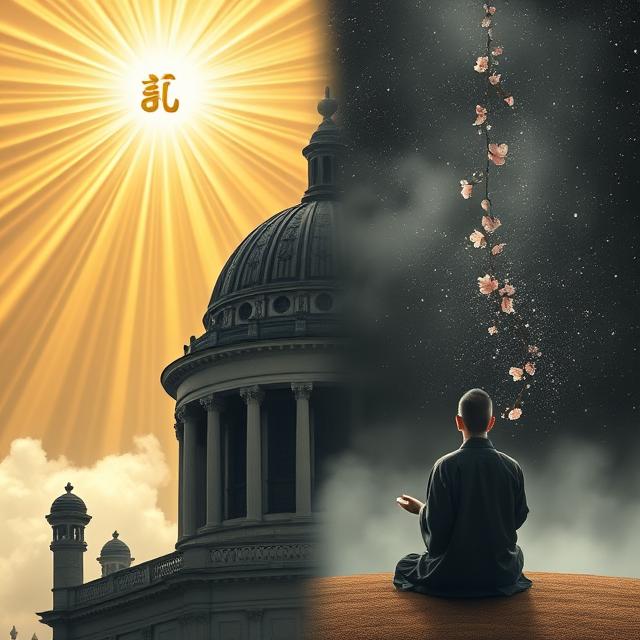
Table of Contents
Logos vs Sunyata: Meaning and Emptiness
Logos vs Sunyata reveals a philosophical and spiritual tension between the West and East: one seeks order through meaning, the other liberation through emptiness. In Christianity, Logos represents divine reason, the Word made flesh, and the intelligible structure of reality. In Mahayana Buddhism, Sunyata or emptiness represents the lack of inherent existence in all things, a foundational insight for awakening.
These two ideas are not merely academic. They reflect how entire civilizations interpret truth, divinity, and the self. In this long-form exploration, we’ll unpack both terms, compare their metaphysical underpinnings, and explore what they offer in our quest for understanding.
I. Logos: The Divine Word and Reason
A. Roots in Greek Philosophy
The term Logos (Greek: λόγος) originally meant “word,” “reason,” or “principle.” Heraclitus used it to describe the rational structure that governs the cosmos. Later, Stoics adopted Logos as a pervasive rationality that ordered all nature.
B. Logos in Christianity
The Gospel of John opens:
“In the beginning was the Word (Logos), and the Word was with God, and the Word was God… and the Word became flesh.”
Here, Logos takes a leap: it is not just a principle but a person—Christ. This Logos:
- Mediates creation
- Embodies divine will and truth
- Offers salvation through meaning and relationality
C. Logos as Foundation of Western Metaphysics
The Logos underpins Western notions of:
- Objective truth
- Divine order
- Rationality as sacred
To believe in Logos is to trust that the universe is intelligible, that God is reasonable, and that truth is discernible through logic and faith.
II. Sunyata: The Emptiness of All Phenomena
A. Origin in Buddhist Philosophy
Sunyata (०८३१८४) means “emptiness” or “voidness.” It is a central concept in Mahayana Buddhism, notably in Nagarjuna’s Mulamadhyamakakarika.
B. Emptiness Is Not Nothingness
Sunyata is not nihilism. It states that:
- All things lack inherent existence
- Phenomena arise interdependently
- Reality is empty of fixed essence
A cup is only a cup because of causes, conditions, materials, and our minds. Its identity is fluid.
C. Purpose of Realizing Emptiness
To realize Sunyata is to:
- Break attachment to fixed views
- Transcend ego and dualism
- Awaken to liberated awareness
Emptiness, paradoxically, is fullness: it opens the possibility for compassion, wisdom, and freedom.
III. Comparative Analysis: Logos vs Sunyata
| Aspect | Logos (Christianity) | Sunyata (Buddhism) |
|---|---|---|
| Meaning | Divine reason and order | Emptiness of fixed identity |
| Goal | Union with God through Christ | Awakening through realizing emptiness |
| Truth | Objective, eternal, personified | Relational, non-dual, beyond words |
| Self | Soul with eternal value | No-self (anatman), impermanent aggregates |
| Method | Faith, revelation, reason | Meditation, direct insight, non-attachment |
| Result | Salvation and eternal life | Nirvana and cessation of suffering |
IV. Can They Coexist or Intersect?
Philosophically, Logos and Sunyata seem oppositional:
- Logos presumes essence; Sunyata denies it
- Logos offers presence; Sunyata unravels it
- Logos builds theology; Sunyata deconstructs it
Yet some mystical interpretations seek synthesis:
- Christian mystics like Meister Eckhart speak of the “Divine Ground,” beyond dualities
- Buddhist-Christian dialogue (e.g. Thich Nhat Hanh and Thomas Merton) explores harmony between emptiness and divine love
Maybe Logos is how reality speaks, and Sunyata is the silence between its words.
V. Relevance to Modern Life
Both ideas address existential suffering:
- Logos comforts the mind by grounding reality in a knowable, loving order
- Sunyata liberates the heart by freeing it from attachment to illusions
In a secular world:
- Logos inspires purpose through rational faith
- Sunyata offers peace through radical detachment
They answer different needs:
- Logos: “There is meaning.”
- Sunyata: “There is freedom in letting go of meaning.”
VI. Conclusion: Two Languages of Transcendence
Logos vs Sunyata is more than a theological dispute. It is a mirror of human longing: to understand, to be free, to belong, to wake up. One says God spoke the universe into being. The other says silence reveals its nature.
Both challenge our assumptions. Both stretch our language. And both, in their own way, invite us to see beyond surface appearances—either toward the Word, or toward emptiness.